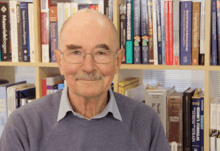Michael F. Ashby
| Michael F. Ashby | |
|---|---|
 A picture of Michael F. Ashby | |
| Born | 20 November 1935 |
| Education | B.A., M.A, Ph.D Natural Science (Metallurgy), Cambridge University, Cambridge |
| Occupation | Royal Society Research Professor, Principal Investigator at the Engineering Design Centre at Cambridge University |
| Known for | Material Information, Material Selection, Granta Design, CES Selector, CES Edupack |
Michael Farries Ashby CBE, FRS, FREng[1] (born 20 November 1935) is a British metallurgical engineer. He is a Royal Society Research Professor, and a Principal Investigator at the Engineering Design Centre at Cambridge University. He is known for his contributions in Materials Science in the field of material selection.[2]
Education
Mike Ashby received his B.A., Natural Science (Metallurgy), Cambridge University, Cambridge, 1957 (First Class Honours); his M.A., Cambridge University, Cambridge 1959; and his Ph.D., Cambridge University, Cambridge 1961.
Work
By conducting numerous studies on the active deformation mechanisms under different temperature conditions, M.F. Ashby developed a graphical approach for determining these mechanisms. He generalizes this approach to the broader field of material selection by developing the software CMS(Cambridge Materials Selector)in collaboration with David Cebon, with whom he co-founded Granta Design Limited. He also collaborated extensively with Yves Bréchet (CNRS Silver Medal). He continued to work on the software to improve its pedagogical value across Materials Education (CES EduPack – used at more than 1000 universities worldwide and value to industry (CES Selector). This software is currently available from the company Granta Design, of which he is the chairman.
Ashby has revolutionized the approach to the selection of materials to take into account four aspects: feature, material, geometry, and processes; moreover, he worked with the division in classes and subclasses. In doing so he has developed a comprehensive approach that associates to the expected mechanical functions of an object a performance index that has to be optimized. These indices allow to better take into account all the properties required of a material, such as specific stiffness (ratio between the elastic modulus and density) instead of single elastic module. His approach allows to rationally choosing the most suitable materials for each application.
In practice, this approach firstly asks to identify the performance index starting from the expected function and geometry. Then it is possible to select thresholds for certain properties in order to select the most useful materials from those present in a database that has some 80,000 materials. The division into classes allows pre-selecting representative materials and therefore working only with certain classes of materials. Finally, the selected materials are shown in a 2-dimensional chart, called the Ashby diagram, in order to view those with the highest performance index. These diagrams often contain also nanostructured materials and composites.
- Materials Selection for Mechanical Design – standard text used around the world.
- Materials and Design – book – Aesthetic attributes as well as technical attributes of materials, making products delightful as well as functional.
- Materials Processing Science and Design- introductory textbook – trying to motivate engineers to learn about materials by starting with design.
In more recent years he has concentrated on materials and the environment and sustainability, writing award-winning textbooks and pioneering teaching methods to get this complex topic across to engineering students. He has been honored by the American Society of Engineering Education by having a teaching prize named after him.
Ashby has achieved a remarkably innovative work in the areas of materials, design, and sustainability as well as in that of pedagogy. His works on materials are comparable to those of Carrega and Colombié.
Honours
He became a Fellow, Royal Society, 1979.[3] He received the A. A. Griffith Medal and Prize, 1981. He became F.ENG (Fellow of the Fellowship of Engineering) in 1993. He became a CBE in 1997. He was made a Foreign Honorary Member of the American Academy of Arts and Sciences, 1993.[4] He was awarded A. Cemal Eringen Medal in 1999.
Publications
- Ashby, Michael F. 'Materials and Sustainable Development', Butterworth Heinemann, 2015.
- Ashby, Michael F. 'Materials and the Environment: Eco-informed Material Choice', Butterworth Heinemann, 2009. 2nd Edition 2012.
- Ashby, Michael F., Shercliff, Hugh and Cebon, David 'Materials: Engineering, Science, Processing, and Design'. Butterworth Heinemann, 2007. 3rd Edition 2013.
- Ashby, Mike and Johnson, Kara 'Materials and Design: The Art and Science of Materials Selection in Product Design' Butterworth Heinemann, Oxford, 2002 ISBN 0-7506-5554-2
- Ashby, M.F. 'How to Write a Paper', 7th Edition 2011.
- Ashby, M.F. 'Materials Selection and Process in Mechanical Design', Butterworth Heinemann, Oxford, 1999 ISBN 0-7506-4357-9
- Ashby, M.F. and Cebon, D. 'Case studies in Materials Selection', First Edition, Granta Design Ltd, Cambridge, 1996.
- Ashby, M.F. and Gibson, L.J. 'Cellular Solids Structure and Properties', Cambridge University Press, Cambridge, 1997 ISBN 0-521-49911-9
- Asbhy, M.F. and Jones, D.R.H. 'Engineering Materials 1, Second Edition', Butterworth Heineman, Oxford, 1996.
- Ashby, M.F. and Jones, D.R.H. 'Engineering Materials 2, Second Edition', Butterworth Heineman, Oxford, 1998.
- Ashby, M.F. and Waterman, N.A. 'The Chapman and Hall Material Selector', Chapman and Hall, London, Volumes 1-3, 1996
- Ashby, M.F. and Frost H.J. 'Deformation-mechanism maps: the plasticity and creep of metals and ceramics', Pergamon, 1982.
- Michael F. Ashby 'Materials Selection in Mechanical Design Pergamon Press 1992 (2nd edition 1999 3rd edition 2005 4th edition 2010)
References
- ↑ "List of Fellows".
- ↑ http://www-edc.eng.cam.ac.uk/people/mfa2.html
- ↑ "List of Fellows of the Royal Society 1660 - 2007" (PDF), p. 15. The Royal Society. Retrieved on 21 February 2009.
- ↑ "Book of Members, 1780-2010: Chapter A" (PDF). American Academy of Arts and Sciences. Retrieved 25 April 2011.